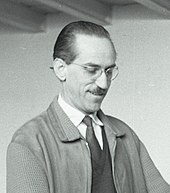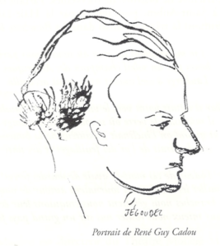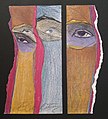Jean Jégoudez
Jean Jégoudez (born July 4, 1915 in Paris , † March 5, 2007 in Grasse ) was a French painter .
Life
youth
Jean Jégoudez grew up in a bourgeois family . Grandfather Léon, a stonemason and sculptor from Brittany, founded a stucco company. Numerous buildings in Paris and France owe their façades (the Claridge and Raphaël Hotels in Paris , Majestic in Nice ) or their interiors (Villa Arnaga by Edmond Rostand in the Basque Country ) to the family business. Jean Jégoudez's father graduated from the École des Beaux-Arts and succeeded him. He himself managed the last few orders until the company was closed.
From 1933 to 1937 he studied at the École nationale supérieure des arts décoratifs and did his military service from 1937, which was followed by several reassignments in 1938/39. In 1940 he was taken prisoner by the Germans in Provins , but shortly afterwards he managed to escape and reach Paris on foot. All these experiences left deep marks and finally made him an anti-militarist, but on the other hand enabled him to get to know the genuine camaraderie of young men from other social and cultural circles. What he experienced during these months emerges in his drawings: fleetingly thrown faces, multiplied or separated by a strong slash.
Appointed by the military government of the French occupation zone, he stayed several times in Germany to help publish the magazines Verger and Die Quelle .
Artistic maturity
The end of the war was followed by two decades of fruitful work. He became close friends with poets such as René Guy Cadou, Luc Bérimont, Jean Bouhier and others from the École de Rochefort . Poetry and painting united and complemented each other, which various illustrations show, e.g. B. Balade de Hurlecoeur by Luc Bérimont (Ed. Cantzsche Verlagsanstalt Stuttgart).
Jean Jégoudez portrayed René Guy Cadou and visited him shortly before his untimely death. This last encounter, as evidenced by a poem dedicated to the painter, shook him deeply. He always remained connected to his friend and his work.
He led a modest life in his studio on rue Notre-Dame-des-Champs , married and in 1951 a daughter was born.
Nature, the true, free, unlimited nature, which he missed so much in his Parisian youth - he could n't stand the Parc Monceau with its well-tended avenues - inspired him all his life. He was called "friend of the trees". At first he drew trees with charcoal or ink, but also the sea and its wide horizon with a few lines. Neither faces nor figures appear in his landscapes. The human presence is only hinted at, be it through a gable, a roof half covered by foliage or a window that frames the landscape - motifs influenced by Pierre Bonnard that he valued very much.
His abstract pictures are powerful, restless painting made of viscous oil, furrowed and swollen, in dark, exquisite colors, occasionally lightened with white or vermilion.
Jean Jégoudez only exhibited in Paris, in galleries in the Faubourg Saint-Honoré (Bing and André Hurtrez) or Rive Gauche (Michel Warren and Rovier).
Under the direction of Dominique de Roux, he worked on the first issues of the Cahier de l'Herne and proposed that the first issue should be dedicated to René Guy Cadou, on the 10th anniversary of his death in 1961. This was followed by 12 abstract lithographs containing a poem by Cadou illustrate “Celui qui entre par hasard dans la demeure d'un poète” in black and white.
The choice of the south
The radiant light of the Côte d'Azur that had charmed the twenty-year-old never left his mind. From 1960 he stayed several times in the Cannes area . Finally he found a dilapidated house in the middle of olive trees, near Saint-Cézaire-sur-Siagne . He bought it and restored it.
In 1966 he designed a wall painting for the natural science faculty of the University of Nantes , a formal-geometric, colorful work, in contrast to his previous work. Other works for schools followed.
After his divorce he married a musician of German origin in 1967. Even before their son was born, they finally settled in the south.
Jean Jégoudez traveled to Paris less and less and lost contact with the artistic circles there. However, he painted and drew tirelessly in his studio, with a view of an almost natural garden. He now preferred gouache and pastel crayons, which enabled subtle color nuances.
The mountainous landscape, the nature with which he lived in complete harmony, were an inexhaustible source of inspiration. In his later drawings the lonely tree reappeared, but in a very different way. It was no longer the majestic tree on a quiet meadow, as it had been in his youth, but a curved, bare trunk, reduced to its simplest form. It represents nature at its core and penetrates from now on into a closed living space. The tree gradually becomes the image of man in the pensive contemplation of the painter, who, seldom inclined to explain, expressed his deepest feelings in his work.
Jean Jégoudez took up another motif that had long dominated him: the eyes. Only the eyes remained of the earlier faces, threatening, ironic or melancholy eyes, eyes of a sad clown. In his last works he combined a drawing with a calligraphic line of a poem that has the words "eyes", "look" or "see".
Shortly after one last trip to the blooming mimosa of the Tanneron massif, Jean Jégoudez died on March 5, 2007 in Grasse .
gallery
Individual evidence
- ↑ Pont-Scorff XIX ° siècle - Chapitre III, Des Destins pas comme les autres au XIX ° siècle (French)
- ^ Jean Rousselot, les cahiers bleus, Musée à contre-courant
- ↑ La pierre et le sel - Actualité et histoire de la poésie - L'école de Rochefort (French)
- ↑ “Amitié à Jean Jégoudez! / Il n'a pas craint de venir chez moi / À travers champs à travers bois / Par un matin jonché de neige! "In poetry collection: Le cœur définitif dans Poésie la vie entière - Seghers (French)
- ↑ Homage to René Guy Cadou in the Maison de la Culture in Bourges in 1965
- ↑ Les revues littéraires - Cahiers de l'Herne (French)
- ↑ Poem by Hélène ou le règne végétal
- ↑ atlasmuseum - unknown title (Jean Jégoudez, Nantes, 1966)
| personal data | |
|---|---|
| SURNAME | Jégoudez, Jean |
| BRIEF DESCRIPTION | French painter |
| DATE OF BIRTH | 4th July 1915 |
| PLACE OF BIRTH | Paris |
| DATE OF DEATH | March 5, 2007 |
| Place of death | Grasse |











